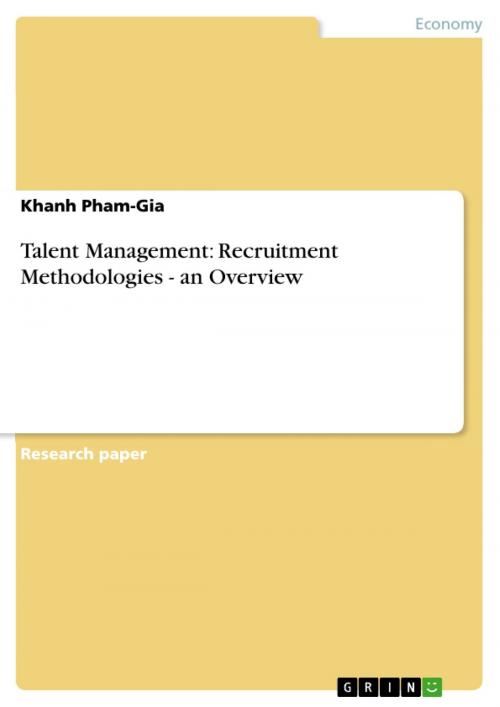Talent Management: Recruitment Methodologies - an Overview
an Overview
Business & Finance, Human Resources & Personnel Management| Author: | Khanh Pham-Gia | ISBN: | 9783640381081 |
| Publisher: | GRIN Publishing | Publication: | July 22, 2009 |
| Imprint: | GRIN Publishing | Language: | English |
| Author: | Khanh Pham-Gia |
| ISBN: | 9783640381081 |
| Publisher: | GRIN Publishing |
| Publication: | July 22, 2009 |
| Imprint: | GRIN Publishing |
| Language: | English |
Research Paper (undergraduate) from the year 2008 in the subject Business economics - Personnel and Organisation, grade: 1.3, University of applied sciences, Munich, language: English, abstract: Employees take a centre stage in companies and play the essential role for business success. Hence, companies have the highest interest to recruit and keep high qualified manpower. In this study, an overview about recruitment methodologies is provided. Additionally, benefits and drawbacks of recruiting methods are analyzed and compared. Recruitment is the discovering and obtaining of potential applicants for actual or anticipated organizational vacancies. Except the recruiting methods applied, many factors could influence the recruiting efforts: image of the organization, attractiveness and nature of the job, internal policies, government requirements, and recruiting budget. There are a high number of recruiting methods which can be classified in different ways: active and passive, internal and external, print and digital methods. The principle sources of recruiting employees include internal search, advertisements (in print or digital media), employee referrals, employment agencies, educational institutions and unsolicited applicants. Recruitment alternatives such as temporary staffing services, employee leasing, and independent contractors can be used meaningfully to acquire the temporary manpower. Because of benefits and drawbacks of different recruiting methods, the task of HR management is to select and apply the right method for an efficient and effective recruiting. The recruiting process provides a basis for the selection of the right candidate and should be well accomplished.
Research Paper (undergraduate) from the year 2008 in the subject Business economics - Personnel and Organisation, grade: 1.3, University of applied sciences, Munich, language: English, abstract: Employees take a centre stage in companies and play the essential role for business success. Hence, companies have the highest interest to recruit and keep high qualified manpower. In this study, an overview about recruitment methodologies is provided. Additionally, benefits and drawbacks of recruiting methods are analyzed and compared. Recruitment is the discovering and obtaining of potential applicants for actual or anticipated organizational vacancies. Except the recruiting methods applied, many factors could influence the recruiting efforts: image of the organization, attractiveness and nature of the job, internal policies, government requirements, and recruiting budget. There are a high number of recruiting methods which can be classified in different ways: active and passive, internal and external, print and digital methods. The principle sources of recruiting employees include internal search, advertisements (in print or digital media), employee referrals, employment agencies, educational institutions and unsolicited applicants. Recruitment alternatives such as temporary staffing services, employee leasing, and independent contractors can be used meaningfully to acquire the temporary manpower. Because of benefits and drawbacks of different recruiting methods, the task of HR management is to select and apply the right method for an efficient and effective recruiting. The recruiting process provides a basis for the selection of the right candidate and should be well accomplished.















